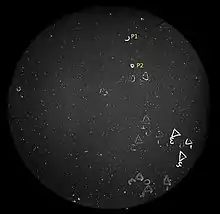| Discovery[1] | |
|---|---|
| Discovered by | Y. Väisälä |
| Discovery site | Turku Obs. |
| Discovery date | 18 October 1939 |
| Designations | |
| (1740) Paavo Nurmi | |
Named after | Paavo Nurmi (Sports Legend)[2] |
| 1939 UA · 1933 DD 1951 YO2 · 1954 NC 1966 TA | |
| main-belt · (inner) | |
| Orbital characteristics[1] | |
| Epoch 4 September 2017 (JD 2458000.5) | |
| Uncertainty parameter 0 | |
| Observation arc | 77.13 yr (28,172 days) |
| Aphelion | 2.9385 AU |
| Perihelion | 1.9947 AU |
| 2.4666 AU | |
| Eccentricity | 0.1913 |
| 3.87 yr (1,415 days) | |
| 43.639° | |
| 0° 15m 15.84s / day | |
| Inclination | 1.9994° |
| 296.10° | |
| 78.724° | |
| Physical characteristics | |
| Dimensions | 12.762±0.150 km[3] |
| 0.046±0.006[3] | |
| Tholen = F[1] B–V = 0.613[1] U–B = 0.194[1] | |
| 13.24[1] | |

1740 Paavo Nurmi, provisional designation 1939 UA, is rare-type asteroid from the inner regions of the asteroid belt, approximately 13 kilometers in diameter.
It was discovered on 18 October 1939, by Finnish astronomer Yrjö Väisälä at Turku Observatory in Southwest Finland.[4] It was named after Finnish distance runner Paavo Nurmi.[2]
Orbit and classification
Paavo Nurmi orbits the Sun in the inner main-belt at a distance of 2.0–2.9 AU once every 3 years and 10 months (1,415 days). Its orbit has an eccentricity of 0.19 and an inclination of 2° with respect to the ecliptic.[1]
The asteroid was first identified as 1933 DD at Heidelberg Observatory in 1933. This observation, however, remained unused and the body's observation arc begins with its official discovery observation at Turku in 1939.[4]
Physical characteristics
On the Tholen taxonomic scheme, Paavo Nurmi has been characterized as a rare F-type asteroid,[1] a subtype of the carbonaceous asteroids, which are common in the outer, but not in the inner main-belt.
Paavo Nurmi has an absolute magnitude of 13.24.[1] According to the survey carried out by NASA's Wide-field Infrared Survey Explorer with its subsequent NEOWISE mission, the asteroid measures 12.76 kilometers in diameter, and its surface has an albedo of 0.046.[3] As of 2017, its rotation period and shape remain unknown.[1]
Naming
This minor planet was named for famed Turku-born Finnish distance runner Paavo Nurmi, also known as The Flying Finn, who won nine Olympic gold medals and set 22 official world records at distances between 1,500 metres and 20 kilometres.[2] The official naming citation was published by the Minor Planet Center on 1 April 1980 (M.P.C. 5281).[5]
References
- 1 2 3 4 5 6 7 8 9 10 "JPL Small-Body Database Browser: 1740 Paavo Nurmi (1939 UA)" (2016-11-23 last obs.). Jet Propulsion Laboratory. Retrieved 7 June 2017.
- 1 2 3 Schmadel, Lutz D. (2007). "(1740) Paavo Nurmi". Dictionary of Minor Planet Names – (1740) Paavo Nurmi. Springer Berlin Heidelberg. p. 138. doi:10.1007/978-3-540-29925-7_1741. ISBN 978-3-540-00238-3.
- 1 2 3 Masiero, Joseph R.; Mainzer, A. K.; Grav, T.; Bauer, J. M.; Cutri, R. M.; Dailey, J.; et al. (November 2011). "Main Belt Asteroids with WISE/NEOWISE. I. Preliminary Albedos and Diameters". The Astrophysical Journal. 741 (2): 20. arXiv:1109.4096. Bibcode:2011ApJ...741...68M. doi:10.1088/0004-637X/741/2/68. Retrieved 20 December 2016.
- 1 2 "1740 Paavo Nurmi (1939 UA)". Minor Planet Center. Retrieved 20 December 2016.
- ↑ "MPC/MPO/MPS Archive". Minor Planet Center. Retrieved 20 December 2016.
External links
- Asteroid Lightcurve Database (LCDB), query form (info Archived 16 December 2017 at the Wayback Machine)
- Dictionary of Minor Planet Names, Google books
- Asteroids and comets rotation curves, CdR – Observatoire de Genève, Raoul Behrend
- Discovery Circumstances: Numbered Minor Planets (1)-(5000) – Minor Planet Center
- 1740 Paavo Nurmi at AstDyS-2, Asteroids—Dynamic Site
- 1740 Paavo Nurmi at the JPL Small-Body Database